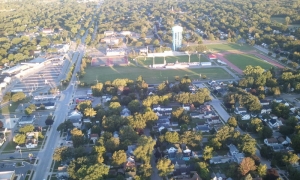History of Austin, MN
Austin, Minnesota is historically and economically well-situated in the south-central part of Minnesota. Founded on the old Territorial Trail, on the south banks of the Cedar River, the county seat of Mower County now stands at the junction of highways U.S. 218, which runs north and south, and Interstate 90, which runs east and west. These provide easy access to the city from all points.
Rich land, trapping, and accessibility brought the first trappers and then the early pioneers to this region. The rich game land attracted a trapper named Austin Nichols, who built the first log cabin and staked his claim in 1853. He later sold the claim to Chauncey Leverich in 1854 and the small community was started.
In the year 1853, there were approximately twenty families in the area, but by 1855 long trains of covered wagons hauling personal belongings and followed by livestock came to the rich prairie. In 1856 there were enough settlers to organize officially a county, and so Mower County began. The same year the tiny community named itself Austin, after the trapper who had built its first log cabin.
Transportation into the little settlement was by stage coach, covered wagon, and oxen team. But as the town grew, the railroads came; and in the years 1867-69, the Chicago, Milwaukee, and St. Paul, with many other small branch lines, started austin on its way to being an important rail center. It became know as a “railroad town,” and the yards and traffic speeded its economic development.
Cedar River power and economic necessity made a saw mill and grist mill the first industries of Austin. Chauncey Leverich built the first saw mill on the Cedar River in 1854-55 and supplied the early settlers with lumber. In 1858 the first grist mill was built by the Truesdell brothers. Before this, flour was oxen-freighted from Decorah, Iowa or Chatfield, Minnesota.
About 1856, a farmer named W. A. Woodson saw the possibilities in austin for meat processing. He butchered and dressed out pork for sale and peddled it in town. Many years later the young George A. Hormel saw the same possibilities and in 1891, Hormel Foods Corporation was established.
Cash was a scarce commodity in those early years, but with the mills, the railroads, and a general increase in business, a bank was needed. Harlan Page opened the first bank in 1866. Austin has three banks now but the earliest United States Government Charter was to the First National in 1868.
The first school was held in a log cabin near Chauncey Leverich’s mill. The year was about 1854-55. In 1856-57 school was held in the Robert Audis Building, from early records it is believed that Maria Vaughn was the first teacher in austin. It wasn’t until 1865 that the first school was built.
In 1897 Charles Boostrom opened the Southern Minnesota Normal College and Austin School of Commerce. This college operated until 1925. In 1940 the public school system opened Austin Junior College. In 1964 it became part of the state system of junior colleges and is now renamed Riverland Community College.
A Methodist circuit preacher held the first church services in town in 1855. First services for the Congregational Church were held in 1857 in the old Headquarters Building, which stood on the north corner of Main Street and Second Avenue Northwest.
The first hotel was started in 1856 by J. H. McKinley.
Dr. Ormanzo Allen came to austin in 1856 as its first physician. Almost thirty years later, in 1896, Dr. O. H. Hegge, together with local and county Lutherans, organized the Austin Hospital Association. As a result St. Olaf Hospital was established as a non-profit organization.
The first newspaper, the Mower County Mirror, was started in 1858. Utilities were necessary, so city wells were dug. Street lamps were ordered and installed. The Oakwood Cemetery was started by the women of the town. Austin’s first library was begun by the Floral Club. In 1856-57 the Headquarters Building was built. This housed the first court, school and church meetings, and public meetings.
The City of Austin is governed by a Home Rule Charter which was framed and adopted March 10, 1903, pursuant to the General Laws of Minnesota. A Home Rule Charter is a charter drawn by the town itself, tailored to its own needs and desires under authority given by the constitution of the state.
In April 1949, the Park and Recreation Board was created through combination of the Park Board, begun in 1902, and the Recreation Board, begun in 1939. Its function is to control and manage austin public parks and recreation activities.
The Jay C. Hormel Nature Center, established in 1971, is composed of the 60 acre Hormel Arboretum, purchased from Geordie Hormel with a state grant.
Riverside Arena, opened in 1973.
Marcusen Memorial Park was dedicated by the City of Austin as a living memorial to those who died in World War I and II. It is a well lighted community baseball park to be used by locally sponsored baseball teams.


